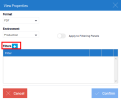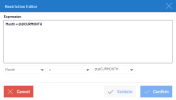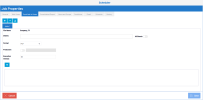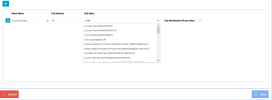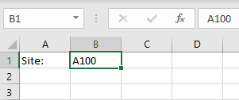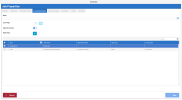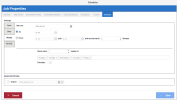Creating a New Job
- Navigate to the Administration section by clicking
.
- Click
Scheduler in the left pane.
-
On the right panel, click
Create a New Job. This opens the Job Properties page with the following tabs:
General
| Setting | Description |
|---|---|
| Description | Describes the actual job. The details are written by the Administrator. |
| Action |
Determines if it will be sent by email or saved on the network.
|
| Status |
Enables or disables the subscription. Tip
In this tab, as in many other places in the Scheduler (and throughout the SEI application), the
language can be changed by clicking |
Web Views
This page gives the option to select the Web Views to run automatically, search from the generic search box or use the filter to search a specific view.
-
Click the Views of your choice and move them to the right box using the arrows.
- Once this is done, the Filter option can be
activated by clicking
.
-
In the View Properties dialog box:
-
Select the format: PDF, HTML, Excel, XML, CSV, or External Link. The export format can be selected for each view.
-
Select the environment on which the view is run.
-
Apply to Filtering Panels: When this option is enabled, the distribution of dashboards uses the Global Parameters used as filters in the filtering panels to impact only the views that have these same Global Parameters.
-
The Filter option allows the selection of specific data to be distributed. Click
to open the Restriction Editor window.
After adding a filter, it appears in window on the right and the
Edit Filter icon appears in the right column. Click it to access the View Properties window. Add as many filters as required by selecting the options using the drop-down list and click Confirm.
-
Click Confirm to close the View Properties dialog box.
-
Excel Add-in Views
The Excel Add-in Views tab allows you to set up one or more Excel Files to be distributed during the Job execution.
-
Click
to choose the Excel file you want to import.
NoteIf you want to add more than one Excel file, click on
to add another file tab then on
to import the file.
Tabs can be removed with
.
-
Click Upload to browse to the location where the file is. The window will display a list of files in the Central Point.
-
Select the file you want to import, click Open then Confirm to get back to the Job Properties window.
-
Once the File Name is determined, define which sheets in the file to distribute in the Sheets field. You can select them all with the All sheets toggle.
-
In the Format field, select the output format:
-
Excel: Excel file with the values only, all the formulas are removed.
-
PDF: Generic static PDF file.
-
CSV: Comma-separated values (excel format).
-
Excel Add-in: Excel file including all the Add-in formulas. The calculation mode will be set to manual.
NoteIf you select Excel or Excel Add-In in the drop-down list, the Reporting Tree feature becomes available. When enabled, it replaces the one distribution file per value slider with one sheet per Reporting Tree node slider. The one sheet per Reporting Tree node slider will remove the Cell Value input column and generate Excel sheets based on the Nodes of the Reporting Tree you set as Distributable in the Administration section.
-
-
In the Protection field, activate the option and enter the password that will unlock the files. Excel and PDF files can be password protected.
-
In the Execution timeout field, set the maximum number of minutes that SEI will wait before canceling.
-
To send a parameter to the Add-in report:
-
Click
- In the first drop-down list, select the sheet in which the parameter will be used.
- In the second field, enter the location the parameter will be sent to (this can be either a cell number or the cell name).
-
In the last field, enter the value to assign to the cell.
NoteGlobal Variables can be used instead of typing the value in manually.
A parameter value can overwrite existing data in the Excel file within the cell.
-
-
Click Save.
It is possible to generate multiple files based on values separated by comma. For example, if you have an Excel file in which you have values regarding Companies and their Fiscal Years as shown below:
- If you leave the default value (meaning, you don't enable any One distribution file per value slider), the scheduler will generate only one file containing the 3 companies and their fiscal year values.
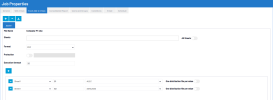
- If you enable the first One distribution file per value slider (the one for the Company), it will generate one file per Company so you would have a file for Company A with the fiscal years 2019 and 2020 and the same will be applied for Company B and Company C.
- If you enable the second One distribution file per value slider (the one for the Fiscal Years), it will generate one file per Fiscal Year and per Company so you would have a file for Company A with the fiscal year 2019, another file for Company A with the fiscal year 2020 and the same will be applied for Company B and Company C.
Consolidated Report
The Consolidated Report tab allows users to merge multiple views (either web-based or Excel Add-In views) into one consolidated PDF report.
Both web-based views (i.e., Worksheets, Charts, Vector Maps, Dashboards, Reports, etc.) and Excel Add-In Views (i.e., Excel sheets) must be in PDF format to be included in a consolidated report. If not, it would not be possible to merge them together, and they would remain separate files.
Fields and Values
-
Name - Text field where users can enter the name of their consolidated report; users can access the translation window to add translations for the name of their consolidated report by clicking the
button.
-
Cover Page - Toggle that allows users to add a cover page to their consolidated report; if activated, users can click the edit button (pencil icon) to the right of the toggle to access the Cover Page editing window.
-
Table Of Contents - Toggle that allows users to add a table of contents to their consolidated report; if activated, SEI automatically generates a table of contents based on the items that were added to the Web Views and Excel Add-in Views tabs; the table of contents appears after the cover page (if enabled) and before the first page of the consolidated report.
TipYou can re-order of the elements (i.e., Views, Dashboards, Reports) in the list by dragging and dropping them in the desired location.
The following fields are displayed in the Page Setup window:
-
Orientation - Allows the user to define whether the final consolidated report will be displayed in portrait or landscape orientation.
-
Paper Size - Allows the user to set a standardized page size (i.e., width and height) for their consolidated report; users can also define a width and height manually by selecting the Custom Size option then entering the desired values in the Width and Height fields.
-
Unit - Allows the user to define the unit of measurement (i.e., centimetres or inches) to be used across all aspects of the consolidated report
-
Width - Field that represents the width of the consolidated report; its value will update automatically depending on the options selected in the previous three fields, however, users will only be able to change the value manually if the Custom Size option is selected in the Paper Size field.
-
Height - Field that represents the height of the consolidated report; its behaviour is identical to the Width field.
-
Font Size - Allows the user to change the font size of their consolidated report text.
-
Page Number - Allows the user to add page numbers to their consolidated report; the user can also select a page number position from the drop-down list; cover pages and tables of content are included in the page numeration, and the page number will appear on those pages (if applicable).
-
Margins - Allows users to configure the margins of their consolidated report. The tab also provides a simplified margin preview in the centre of the Page Setup window which updates in real time based on the values entered by the user.
-
Top, Left, Right and Bottom - Fields that allow the user to define the distance between their consolidated report content and the border of the page in all four directions.
-
Default - Button that causes all consolidated report margins to revert to their initial, default values.
-
Users and Groups
In the Users and Groups tab, the user can select the users and/or groups to receive automatic emails generated by the Job. At least one user needs to be selected in order for the Job to be saved.
The Scheduler will execute the view for each user or group defined, according to the security defined for them. If a view is sent to a group, only the users with the proper access will receive it, and the data in the views sent will also reflect the security access of the users, meaning that individual users may receive very different results.
It also takes into consideration the local settings of each user, for instance, sending the information in English for an English defined user or French for a French defined user, etc.
If you drag the Run As slider to the right, it will apply the security access of the selected user to the others.
To send emails to SEI users:
- Select a user from the table on the left.
- Click the arrow to move the user to the table on the right.
- (Optional) Drag the Run As slider to the right.
- Click Save.
- Go to the Email tab to write the body of your message and the subject.
To send emails to unregistered (external) users:
- Drag the Run As slider to the right.
- Add their emails into the To, Cc or Bcc fields.
- Click Save.
- Go to the Email tab to write the body of your message and the subject.
Conditions
This tab allows you to add a condition to the Data Model where the View is extracted.
Scenario
You receive invoices every day, but only want to receive the ones from the previous day. Based on that principle, you set up the Scheduler to generate a report only if that data exists. In this example, you would select an Invoice By Customer view and apply a filter from the Web Views tab to display only the data from the day before. Then you would add the following condition:
- Click
Add Condition.
- Click
to enter your SQL condition into the Restriction Builder and click on Save.
- Click Confirm to finish.
Conditions apply at the Data Model level and not at the View level.
The condition does not filter the view but rather, it checks if the condition exists.
The conditions defined in the Conditions tab must be applicable to all views that are involved in a job. If you have multiple conditions applied to multiple views, the job will not be performed if even one of your conditions cannot be applied to one of the selected views.
That means that if you want to create a job involving multiple views with incompatible conditions, you must create a separate job for each group of compatible views and conditions.
This tab is only accessible if you have selected Export and Email in the Action drop-down list of the General tab.
Use this tab to add a message (Description) and a Subject to the email sent by the Scheduler.
If you want to send emails to unregistered users, you can add their emails into the To, Cc or Bcc fields in the Users and Groups tab.
You can also use Global Variables and Special Variables within the Header and the Body of the email. Note that the variables will be resolved based on the running user with the default environment.
Hello ##CurrentUser, here is your report for today @@CURDATE
##CurrentUser, here is your report for today @@CURDATE
Uppercase and lowercase letters (A-Z, a-z), digits (0-9), and the underscore (_) symbol cannot be attached at the end of a global variable name.


